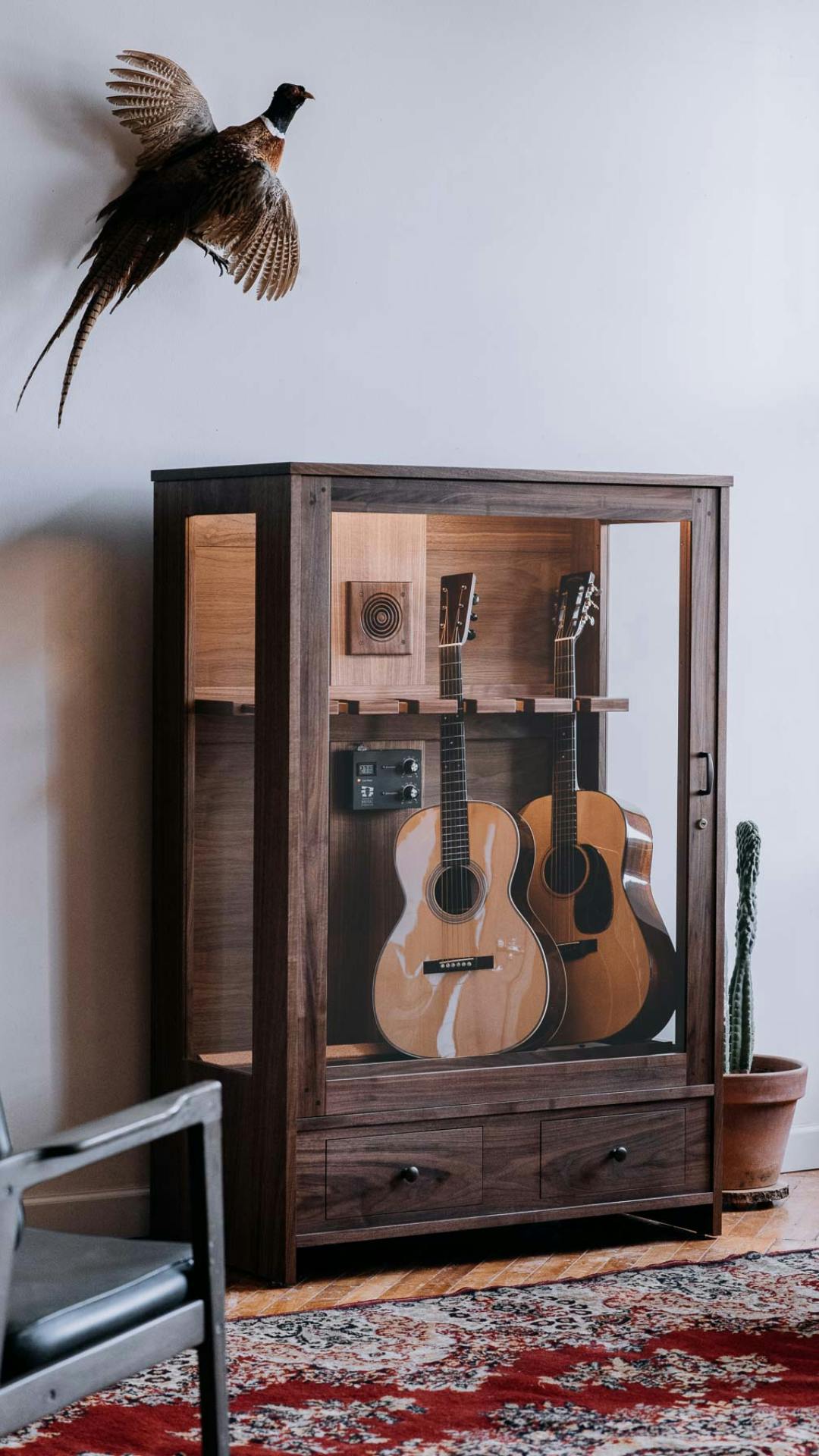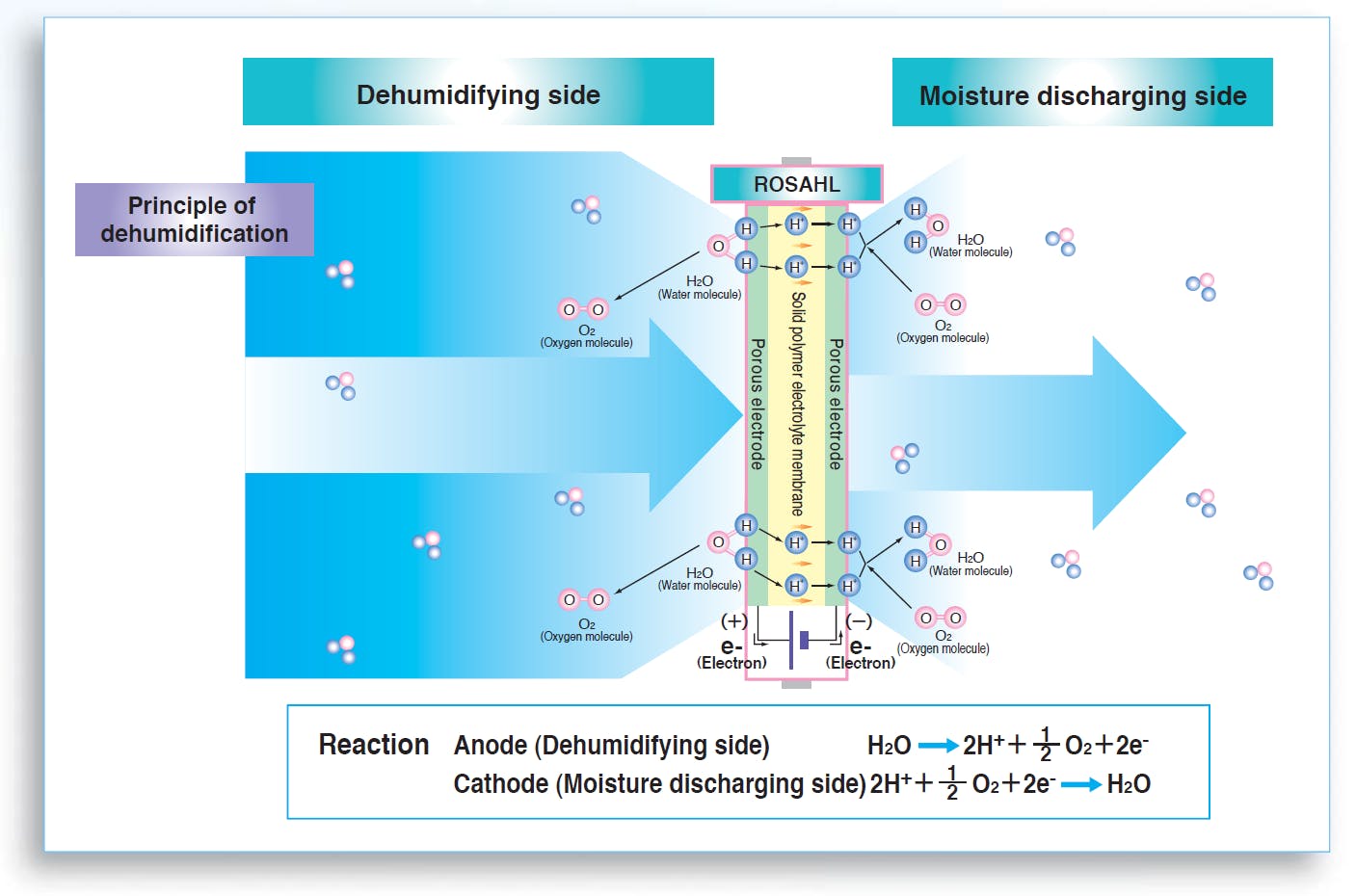Dehumidifying A Guitar What You Need To Know
Understanding Guitar Humidity and Dehumidification
When preserving and caring for your stringed instruments, maintaining the ideal humidity level for your guitars is essential to their structural integrity, longevity, and feel. The ideal guitar humidity level is 45% relative humidity (RH) at 70 degrees Fahrenheit. That being said, depending on a multitude of factors, you may need to add or remove moisture in order to achieve the “safe zone” of 40% – 60% RH throughout the year. In this article, we’ll give a quick overview of humidification, and help you decide if adding a dehumidification system to your guitar display case is necessary…
Guitar Humidity Basics
First, as previously mentioned, the ideal level for storing and preserving instruments is 45% RH at 70 degrees Fahrenheit. Click the following link if you’re looking for a complete guide to understanding the effects of humidity on instruments, and how to correctly humidify a guitar. Understanding the signs of under-humidification such as top-seam cracks is just as important as understanding over-humidification. However, when utilizing a guitar humidifier such as a guitar humidor or others, your local climate, type of home, and how you heat & cool it is all pertinent factors to protecting them.
Guitar Humidifiers & Their Function: Adding Moisture
At AMF, each of our guitar display cabinets includes a humidification system built into each display. Our patented doors, seals, and construction process along with this system provide optimal humidity control. These carefully constructed cabinets add moisture to the instruments in order to preserve them at 45% RH via a 1-gallon reservoir. The function of this system is what the majority of our clients across the world have utilized for the past decade during the winter months when humidity is low. However, customers residing in particularly humid climates may need to dehumidify their instruments throughout the year in order to maintain that ideal 45% humidity.

Signs Of Over-Humidification in Guitars
Though most damage done to guitars is a result of under-humidification, over-humidification can be just as detrimental and expensive to repair, if not more. A few common signs of over-humidification due to the wood holding too much moisture include:
- Swelling: Also known as bellying, raised wood behind the bridge. This is typical with acoustics & archtops.
- Topwood Seam Splits: Typically affect acoustic guitars starting behind the bridge with straight line cracks.
- High Action: Strings are further away from the fretboard than usual.
- Oxidized Frets: The frets on your acoustic or electric guitar show signs of rust (brown) and often feel like sandpaper when bending notes.
How To Dehumidify a Guitar: Removing Moisture
If you reside in a climate that is particularly humid throughout the year, you may need a tool to lower the humidity from your instruments. This is where the dehumidification system add-on can be utilized. In addition to humidification, we also offer an ionic dehumidifier membrane, which preserves your stringed instruments by removing excess moisture to maintain a safe level of humidity in your cabinet.
How Our Guitar Dehumidifier Works
The DRH system is a unique dehumidifier that utilizes a solid-state polymer ionic membrane to electrolytically decompose and remove moisture from the air by electrolysis when a 3V DC is applied. This unit will provide a clean moisture extraction with a silent performance at all times. Doing so, will help regulate the relative humidity as needed in order to maintain what we refer to as the “guitar humidity safe zone”: 40% – 60% RH. *Note* Our DRH system needs to be added while building your custom cabinet and cannot be added after the cabinet is completed.
When a voltage is applied to the porous electrode attached to the SPE, the moisture on the anode side (dehumidifying side of the membrane) dissociates into hydrogen ions (H+) and oxygen; the hydrogen ions migrate through the membrane to be discharged on the cathode (moisture discharging side of the membrane) side where they react with oxygen in the air, resulting in water vapor being discharged. The graphic below describes the process:

Do I Need to Dehumidify My Guitars?
Now, with an understanding of how proper humidification and dehumidification, it’s time to discuss the environments in which purchasing the dehumidification system with your guitar display case may be necessary. Below are a few examples of climates and common living situations that often necessitate our dehumidification add-on in order to safely maintain and preserve instruments. Please note that there are exceptions to the rule. Typically, dehumidification is necessary for…
- Those who reside in a tropical climate with an average humidity level of 50% or higher for the majority of the year
- Those who reside in an oceanfront home
- Those who reside in a home without a central heating & cooling system.
- Those who reside in a home with poor ventilation
- Those who reside in a ground-floor home
- Those whose guitar display case is located in an area of the home that is particularly damp (such as a basement)
Highest Average Level of Relative Humidity (Top 10 States):
- Alaska (77.1%)
- Florida (74.5%)
- Louisiana (74.0%)
- Mississippi (73.6%)
- Hawaii (73.3%)
- Iowa (72.4%)
- Michigan (72.1%)
- Indiana (72.0%)
- Vermont (71.7%)
- Maine (71.7%)
How To Measure Guitar Humidity Levels in Your Home
If you’re still unsure of whether you’re going to need to purchase dehumidification with your guitar display case from American Music Furniture, we suggest gathering some data based on your home’s unique environment via a hygrometer. At AMF, our team of makers and musicians trust the products offered by Govee including their Bluetooth + Wi-Fi enabled hygrometers, which gather data, alert you to customizable RH set points, and allow you to monitor them 24-7 anywhere in the world. To gather data, set the hygrometer in the area where you would like to store your AMF cabinet and consider other factors such as climate throughout the year, location in the home, and others to find the best placement. Then set your hygrometer alerts to 40% lowest and 60% highest. This way it will alert you whenever it’s outside of the guitar humidity safe zone. If you notice that the humidity level is typically pushing the safe zone or above, you may need to add the DRH to your cabinet.
Recap & Need To Know:
- Ideal Guitar Humidity: 45% at 70 Degrees F
- Guitar Humidity Safe Zone: 40% – 60% RH
- Homes with an avg. humidity of 50%+ throughout the year may need to dehumidify
- Purchase a hygrometer to measure and monitor the humidity level where you store your guitars
American Music Furniture Co.
For the past decade, AMF has been the number one guitar display case and custom furniture maker for music listening rooms, guitar preservation displays, large built-ins, and more. As leading experts in instrument preservation and the integration of music into the home, we strive to produce for our customers around the world the best design and hand-crafted furniture solutions for making music. For more information about guitar humidification check out our blogs. To order your custom piece, call us today! 267-272-2460 or click below to purchase your cabinet!